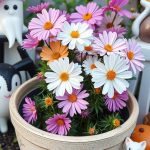Container gardening is a fantastic way to enjoy the joys of planting, especially if space is limited or the soil isn’t quite right. It allows you to grow everything from herbs and vegetables to beautiful flowers right on your balcony, patio, or even indoors. With just a few pots and some dirt, you can create a mini garden that suits your style and needs, making it ideal for both beginners and experienced gardeners alike.
Seasonal Planting Ideas for Containers
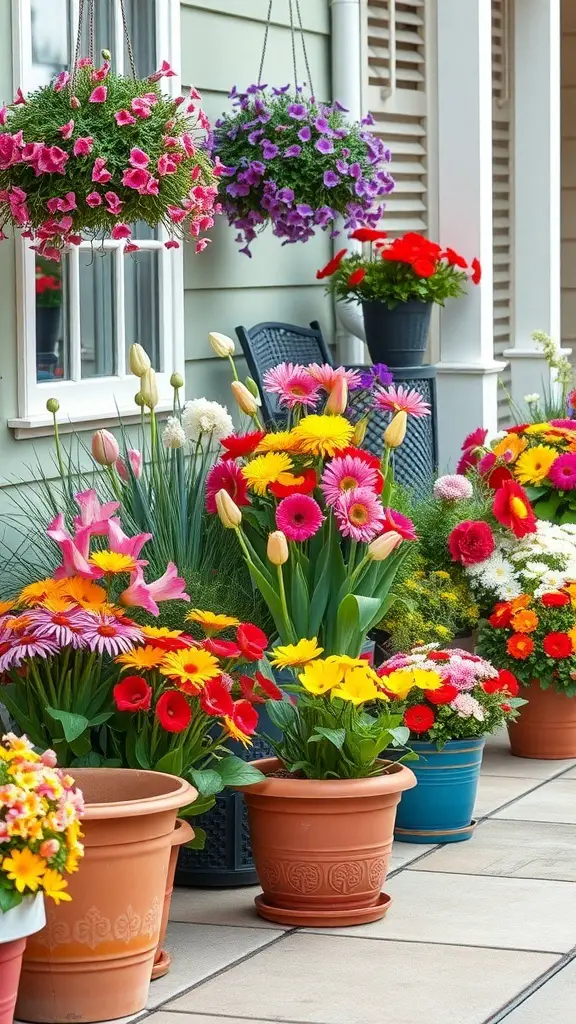
Container gardening is a fun way to bring color and life to any space. The image shows a vibrant display of flowers in various pots, showcasing how seasonal planting can brighten up your home or garden.
In spring, consider planting tulips and daisies for a cheerful look. These flowers thrive in the warmer weather and add a splash of color. For summer, bright gerbera daisies and petunias can create a lively atmosphere.
As fall approaches, switch to chrysanthemums and ornamental peppers. These plants not only look great but also bring in the autumn vibes. Finally, winter containers can feature evergreens and winter pansies, keeping your outdoor space looking fresh even in the cold months.
Mixing different types of flowers and plants can create a stunning visual effect. Don’t forget to consider the height and texture of each plant for a balanced look!
Herb Gardens in Small Spaces
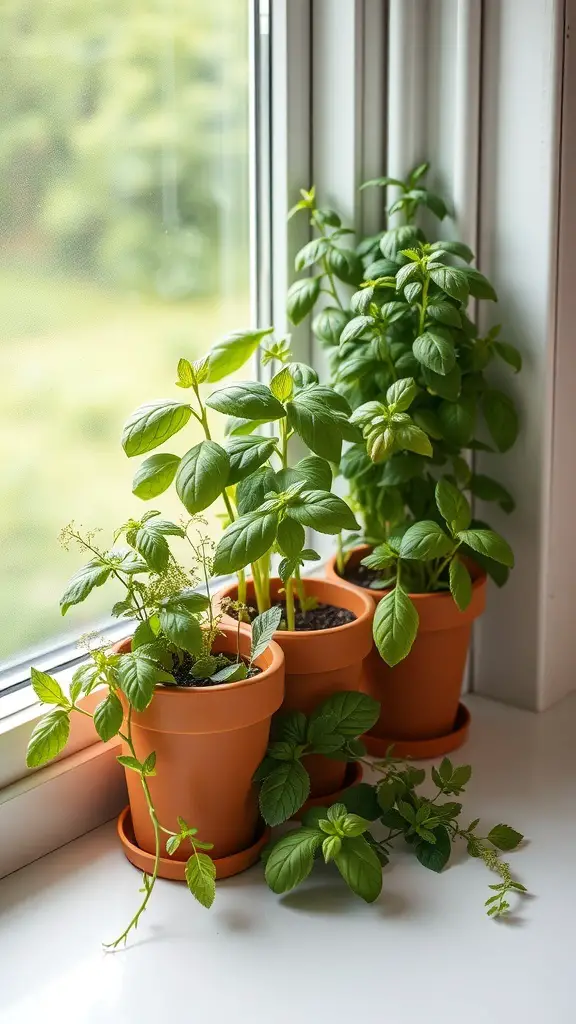
Container gardening is a fantastic way to grow herbs, especially in small spaces. The image shows a few pots filled with vibrant green herbs, sitting on a windowsill. This setup is perfect for anyone looking to add fresh flavors to their cooking without needing a large garden.
Using pots allows you to control the environment for your herbs. You can choose the right soil, manage water levels, and even move them around to catch the best sunlight. Herbs like basil, mint, and parsley thrive in these conditions and can be easily accessed right from your kitchen.
Another advantage of container gardening is the ability to create a mini herb garden indoors. This not only brightens up your space but also provides fresh ingredients year-round. Just imagine snipping off some fresh basil for your pasta or mint for your tea!
Maintaining these herbs is simple. Regular watering and occasional trimming will keep them healthy and productive. Plus, it’s a rewarding experience to watch them grow and enjoy the fruits of your labor in your meals.
Soil Mix Essentials for Container Gardening
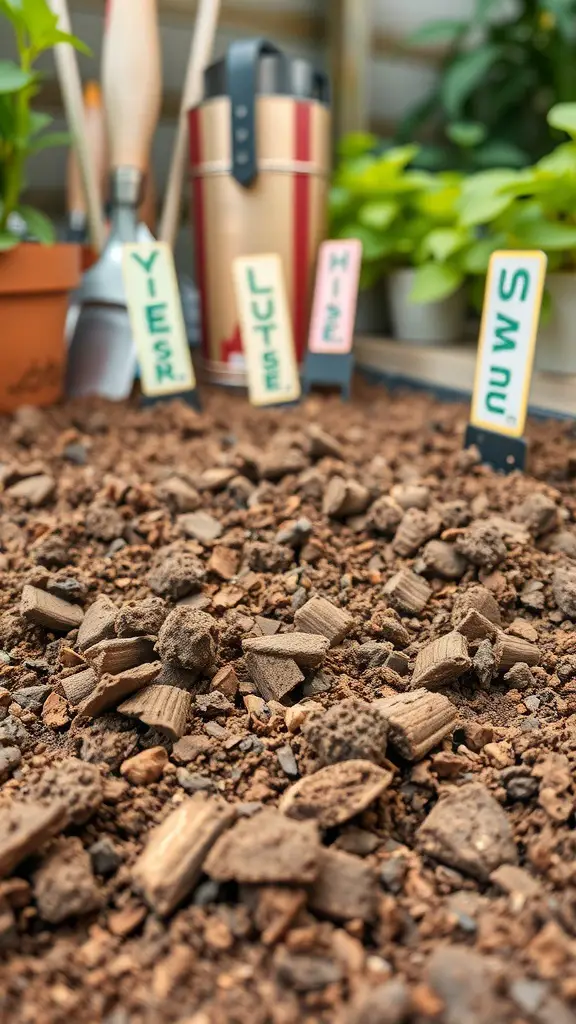
Container gardening is a fun and rewarding way to grow plants, and the right soil mix is key to success. The image shows a close-up of soil with various textures and materials, hinting at the importance of a good mix.
When creating your soil mix, consider using a blend of potting soil, compost, and perlite. This combination provides nutrients, good drainage, and aeration. The soil in the image looks rich and well-prepared, perfect for supporting healthy plant growth.
Don’t forget to add some organic matter, like shredded bark or coconut coir, to improve moisture retention. The small labels in the background suggest a well-organized approach to gardening, which can help you keep track of different plants and their needs.
Lastly, remember to check the pH of your soil. Most plants thrive in slightly acidic to neutral pH levels. A simple soil test can guide you in making adjustments to create the best environment for your container garden.
Watering Techniques for Potted Plants

Watering potted plants can feel like a simple task, but there’s a bit more to it than just pouring water in. The image shows a person watering various plants in pots, showcasing the joy of nurturing greenery. Each plant has its own needs, and understanding those can make a big difference.
One effective technique is to check the soil moisture before watering. Stick your finger about an inch into the soil. If it feels dry, it’s time to water. If it’s still moist, hold off a bit longer. This helps prevent overwatering, which can harm your plants.
Another handy tip is to water deeply but less frequently. This encourages roots to grow deeper into the soil, making plants stronger. Using a watering can with a spout, like the one in the image, allows for precise watering, ensuring that each plant gets the right amount.
Consider the time of day for watering. Early morning is often best, as it allows plants to absorb moisture before the heat of the day. This can help reduce evaporation and keep your plants hydrated longer.
Companion Planting in Containers
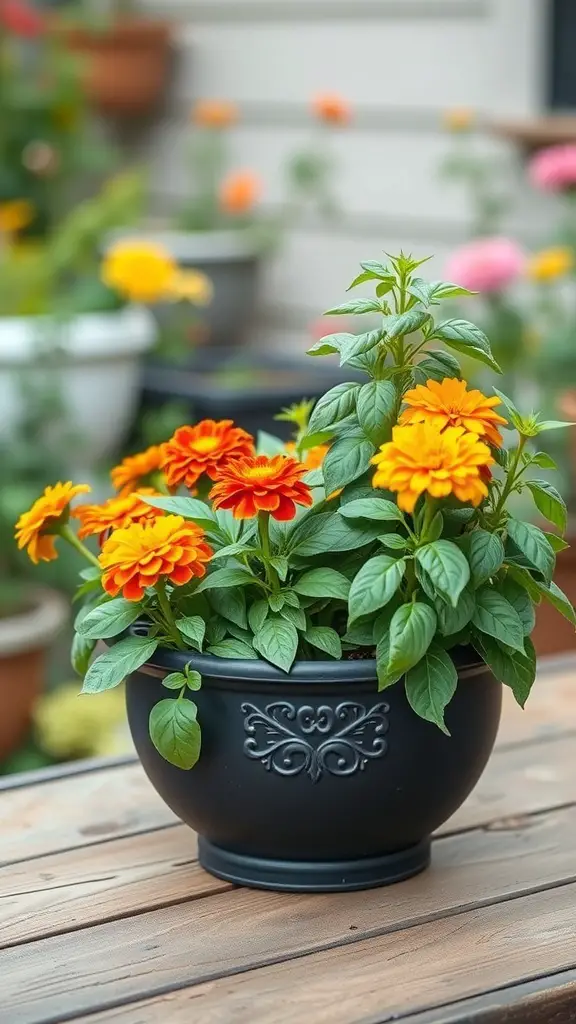
Container gardening is a fun way to grow plants, and companion planting can make it even better. The image shows a beautiful arrangement of vibrant orange and yellow flowers in a stylish black pot. These colors not only brighten up any space but also attract beneficial insects.
When choosing plants for your containers, think about how they can support each other. For example, pairing flowers with herbs can enhance growth and flavor. Marigolds are a great choice as they repel pests while adding a pop of color.
Consider the size of your containers too. Larger pots can hold more plants, allowing for a diverse mix. This diversity can lead to healthier plants and a more visually appealing display. Plus, it’s a great way to experiment with different combinations!
Don’t forget about the watering needs of your plants. Grouping plants with similar water requirements can make maintenance easier. This way, you can enjoy your container garden without the stress of constant upkeep.
Creating Vertical Gardens with Containers
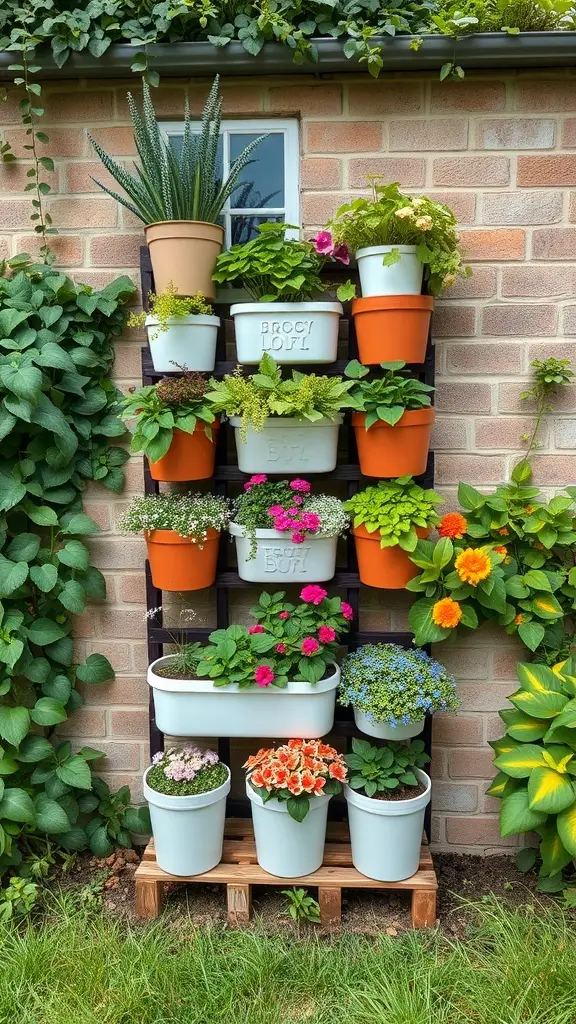
Vertical gardens are a fantastic way to maximize space and add beauty to your home. The image shows a vibrant vertical garden made with various containers stacked against a wall. This setup not only looks great but also allows you to grow a variety of plants in a small area.
Using different pot sizes and colors can create a visually appealing display. The mix of flowers and greenery adds life and color, making any space feel more inviting. You can choose plants based on your preferences, whether you like bright blooms or lush foliage.
Consider using lightweight containers to make it easier to rearrange your garden as needed. A sturdy shelf or rack can hold the pots securely while allowing for good drainage. This setup is perfect for small yards, patios, or even balconies.
Don’t forget to think about sunlight and watering needs for each plant. Grouping plants with similar requirements can help keep your garden thriving. With a little creativity, you can turn any wall into a stunning vertical garden.
Best Vegetables for Container Growth
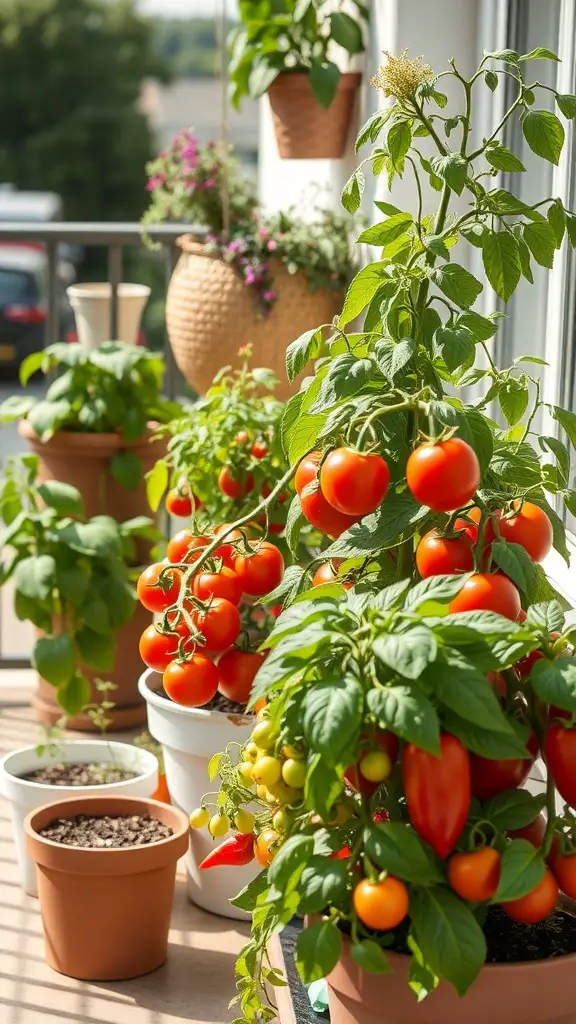
Container gardening is a fantastic way to grow your own vegetables, especially if space is limited. The image shows a vibrant collection of tomato plants, showcasing their bright red and yellow fruits. These plants thrive in pots, making them perfect for balconies or small yards.
Tomatoes are among the best vegetables for container growth. They need plenty of sunlight and regular watering, which is easy to manage in pots. Choose varieties like cherry or patio tomatoes for smaller spaces.
Other great options include peppers, which come in various colors and sizes. They add a pop of color to your garden and are relatively easy to care for. Herbs like basil and parsley also do well in containers, providing fresh flavors for your meals.
Don’t forget about leafy greens! Spinach and lettuce can flourish in pots and are quick to harvest. They’re perfect for salads and can be grown alongside your tomatoes.
Overall, container gardening opens up many possibilities. With the right vegetables, you can enjoy a bountiful harvest right from your home.
Choosing the Right Containers for Your Plants
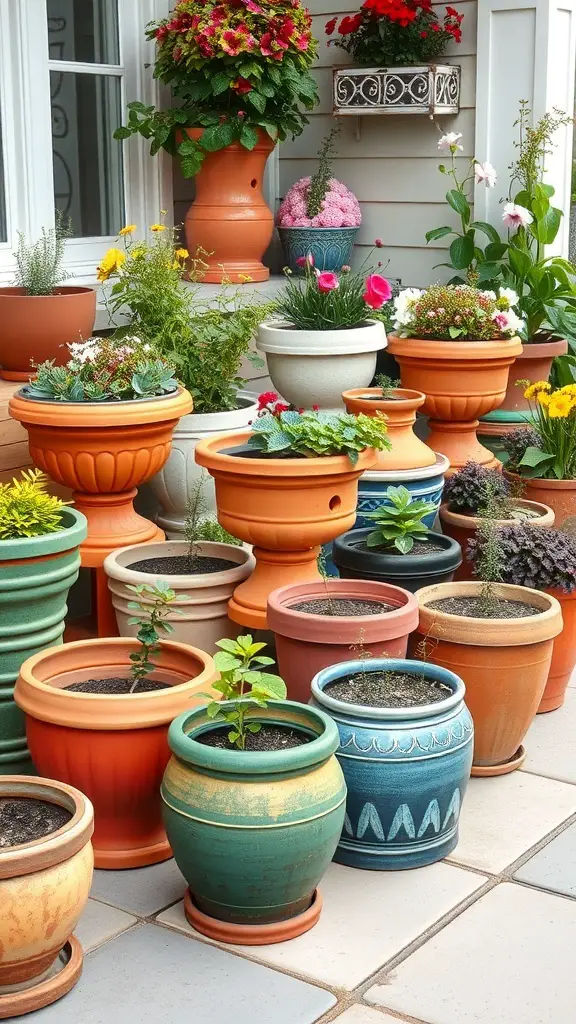
When it comes to container gardening, the right pots can make all the difference. The image shows a vibrant collection of pots in various shapes, sizes, and colors. Each container is filled with lush plants, showcasing how diverse and beautiful container gardening can be.
First, think about the size of your plants. Larger plants need bigger pots to grow healthy roots. Smaller plants can thrive in compact containers. Mixing sizes can create a lovely visual effect.
Next, consider the material of the pots. Clay pots are great for drainage but can dry out quickly. Plastic pots retain moisture longer, which can be helpful in hot weather. Choose what fits your gardening style and climate.
Don’t forget about drainage holes! They help prevent water from pooling at the bottom, which can harm your plants. If you find a pot you love that lacks drainage, you can always add some rocks or gravel at the bottom.
Lastly, let your creativity shine! Use colorful pots to brighten up your space or stick to neutral tones for a more classic look. The variety in the image is a perfect example of how different containers can complement each other and enhance your garden.
Fertilizing Container Plants Effectively

Fertilizing your container plants is key to keeping them healthy and thriving. The image shows a gardener mixing fertilizer into the soil, which is a great practice to boost plant growth.
Using the right fertilizer can make a big difference. Look for slow-release options that provide nutrients over time. This way, your plants get what they need without overwhelming them.
It’s also important to follow the instructions on the fertilizer package. Over-fertilizing can harm plants, so stick to recommended amounts. Regularly check your plants for signs of nutrient deficiency, like yellowing leaves.
Watering after fertilizing helps nutrients reach the roots. Make sure to keep an eye on moisture levels in your containers, as they can dry out faster than garden beds.
Choosing the Right Location for Your Containers
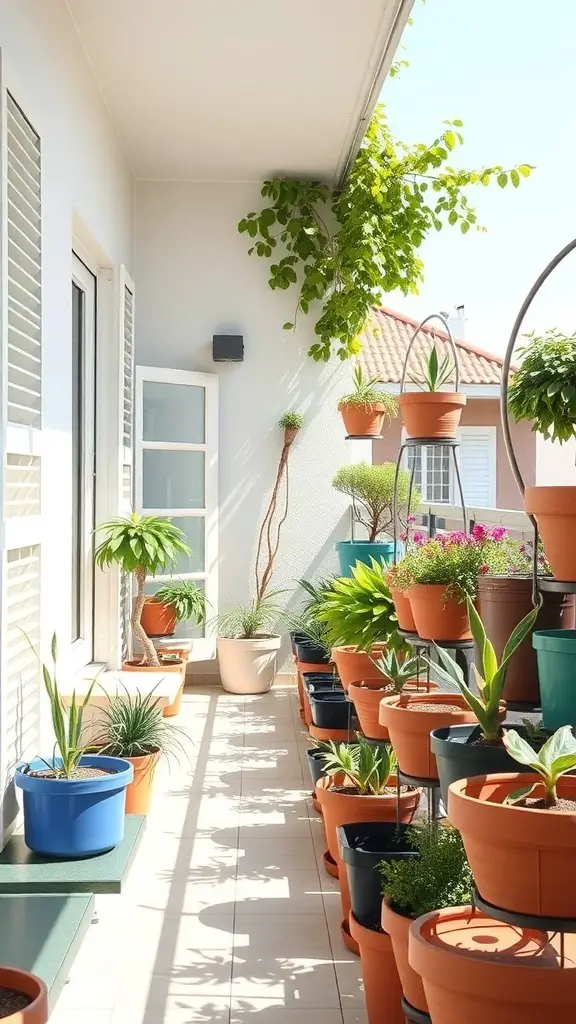
When it comes to container gardening, picking the right spot is key. The image shows a lovely balcony filled with various plants in pots, soaking up the sun. This setting highlights how important light is for your plants.
Start by observing how much sunlight your chosen area gets throughout the day. Most plants thrive in bright, indirect light, while some love full sun. The plants in the image seem to enjoy a sunny spot, which helps them grow strong and healthy.
Next, think about accessibility. You want to place your containers where you can easily water and care for them. The layout in the image makes it easy to reach each pot, ensuring that every plant gets the attention it needs.
Lastly, consider the wind. If your location is windy, it might be wise to choose heavier pots or place them against a wall for protection. The plants in the image appear well-anchored, suggesting they can withstand breezy days.
Managing Pests in Container Gardens

Container gardening can be a delightful way to grow plants, but pests can sometimes crash the party. The image shows a gardener in action, carefully inspecting plants while surrounded by various pots. This hands-on approach is key to keeping your container garden healthy.
Regular checks are important. Look for any signs of pests like tiny holes in leaves or sticky residue. If you spot something, act quickly. Use organic pest control methods whenever possible, such as neem oil or insecticidal soap. These options are gentle on your plants but tough on unwanted visitors.
Another tip is to encourage beneficial insects. Ladybugs and lacewings can help keep pest populations in check. Planting flowers like marigolds can attract these helpful critters. Remember, a little prevention goes a long way in maintaining a thriving container garden.
Creative Container Arrangements
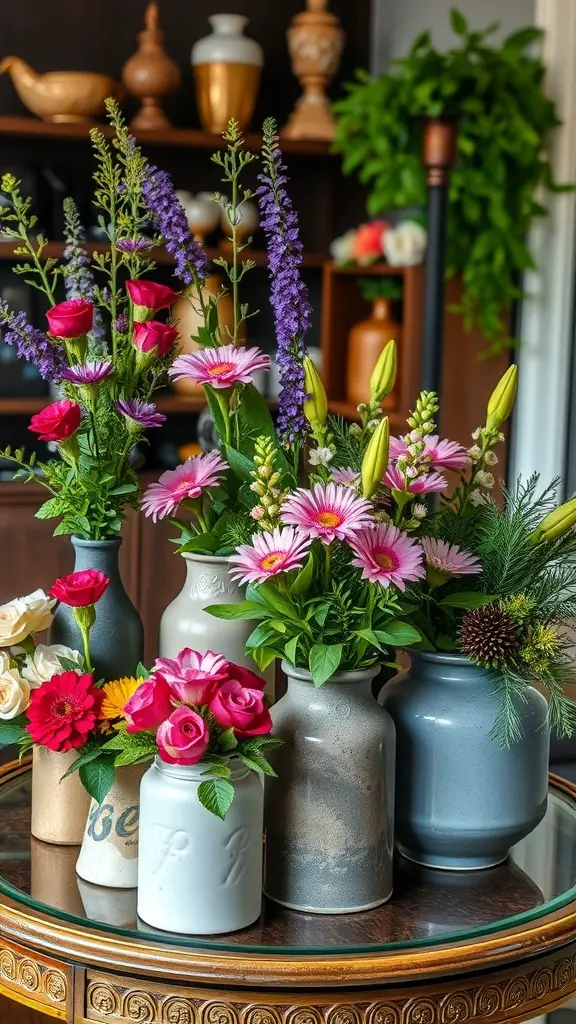
Container gardening opens up a world of creativity. The image showcases a delightful arrangement of flowers in various containers, each adding its own charm. Using different vases and jars can make your garden pop with personality.
Mixing colors and textures is key. Notice how the vibrant pinks and purples of the flowers contrast beautifully with the muted tones of the containers. This combination creates a lively yet harmonious look.
Don’t shy away from using unique items as containers. Old jars, teapots, or even tin cans can serve as quirky planters. This not only recycles materials but also adds character to your garden.
Layering heights in your arrangement can also enhance visual interest. Taller flowers can stand in the back, while shorter blooms can fill in the front. This creates depth and draws the eye across the display.
Lastly, consider seasonal themes. Changing your arrangements with the seasons can keep your space fresh and inviting. Whether it’s bright blooms for spring or warm tones for fall, there’s always a way to keep things exciting.
Sustainable Practices in Container Gardening
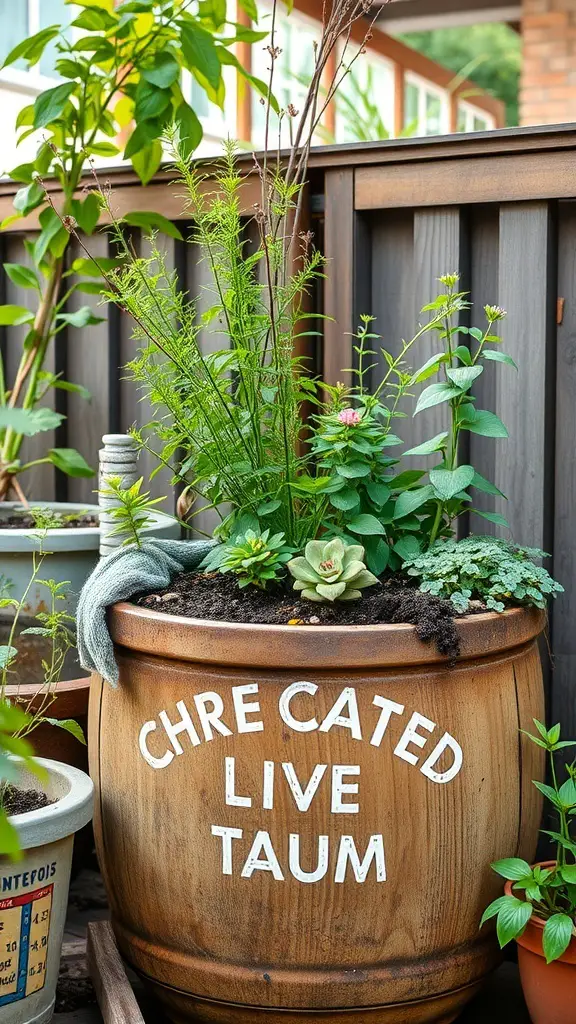
Container gardening is a fun way to grow plants, especially in small spaces. The image shows a beautifully arranged pot filled with various plants. This setup not only looks great but also promotes sustainability.
Using recycled materials for pots is a smart choice. The wooden barrel in the image is a perfect example. It adds character and helps reduce waste. You can also use old containers or even upcycle items like tin cans.
Choosing native plants is another sustainable practice. They require less water and care, making them ideal for container gardening. The plants in the pot look healthy and vibrant, showing how well they thrive in this environment.
Water conservation is key. Using a drip irrigation system or self-watering pots can help maintain moisture without wasting water. This is especially important in areas with limited rainfall.
Lastly, composting kitchen scraps can enrich the soil in your containers. This practice not only reduces waste but also provides nutrients to your plants, leading to a thriving garden.
Winter Care for Container Plants
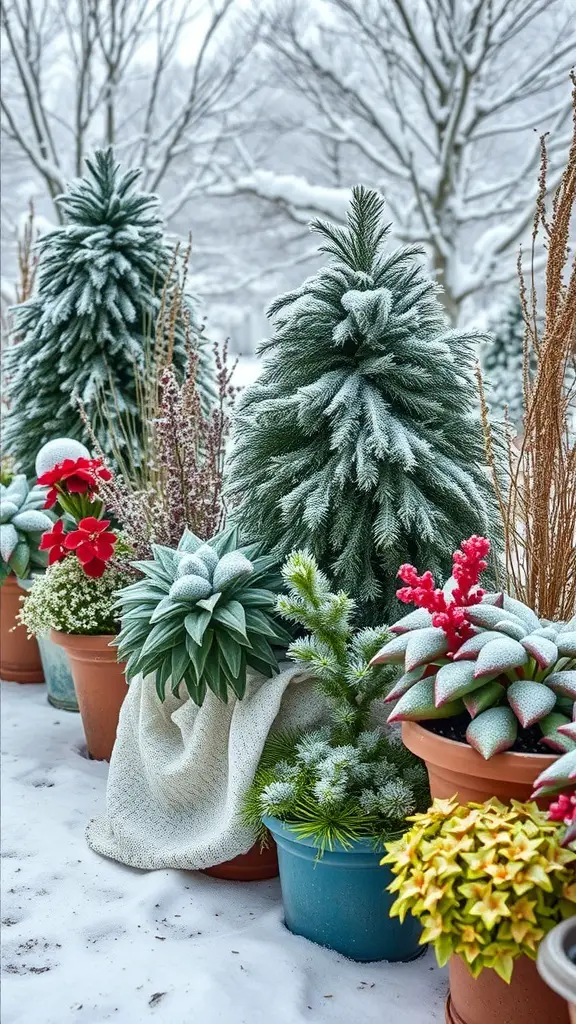
Winter can be tough on container plants, but with a little care, they can thrive even in the cold. The image shows a beautiful arrangement of various plants, some dusted with snow, which highlights the need for proper winter care.
First, consider moving your containers closer to the house. This helps protect them from harsh winds and extreme temperatures. Grouping pots together can create a microclimate, keeping them warmer.
Next, use mulch or blankets to insulate the soil. This keeps the roots from freezing and helps retain moisture. The plants in the image are wrapped in a cozy blanket, showing how simple it can be to provide extra warmth.
Watering is still important in winter. Even though plants may not be growing as much, they still need hydration. Check the soil moisture regularly and water when necessary, especially on warmer days.
Lastly, consider using frost cloths or plant covers during particularly cold nights. This extra layer can protect delicate plants from frost damage. The colorful plants in the image remind us that with the right care, container gardening can bring joy even in winter.
DIY Container Gardening Projects

Container gardening is a fun and creative way to bring greenery into your space. The image shows a vibrant setup filled with various plants in stylish pots. This is perfect for anyone looking to start their own container garden.
Look at those different pots! Each one has its own charm, and they can fit into any decor style. You can mix and match colors and textures to create a unique look. Using containers also makes it easy to move plants around to find the best light.
Consider using herbs like basil or mint in smaller pots. They not only look great but can also be used in your cooking. Larger pots can hold beautiful flowers or even small shrubs, adding a splash of color to your patio or balcony.
Don’t forget about the tools! The image features handy gardening tools that make planting and maintenance a breeze. A good pair of scissors and a watering can are essential for keeping your plants healthy.
Overall, container gardening is accessible for everyone, whether you have a big yard or just a small balcony. It’s all about getting creative and enjoying the process!

